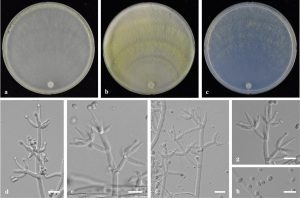Trichoderma koreanum S-Y. Oh, M.S. Park & Y.W. Lim
Index Fungorum number: IF824661; Facesoffungi number: FoF 04459; Fig. 1
Etymology: The specific epithet ‘‘koreanum’’ refers to the type locality.
Holotype: SFC20131005-S066.
Colour codes follow: Methuen Handbook of colour (Kornerup and Wanscher 1963).
Sexual morph: Undetermined. Asexual morph: Hyphomycetous. Conidiophores branched at an acute or right angle to the main axis, mostly unpaired. Phialides 8.6–13.4 × 2.4–3.7 μm, l/w 2.5–4.9, 1.7–2.6 μm wide at the base (n = 30), typically formed in whorls of 3–5, subulate or lageniform. Conidia smooth, subglobose to ellipsoid, 3.1–4.4 × 2.6–3.3 μm, l/w 1.1–1.4(−1.5) (n = 30).
Culture characteristics: On CMD after 72 h, colony radius 17–22 mm at 15 °C, 29–35 mm at 20 °C, 44–49 mm at 25 °C, 20–29 mm at 30 °C; colonies on CMD fill a 90 mm diam. Petri dish within 5 days at 25 °C. Colony hyaline, radial, indistinctly zonate, aerial hyphae spreading uniformly throughout the colony. Conidiation starts after 4 days, with light green (M. 28A5) or deep green (M. 27E8) conidia forming in pustules, appearing around the margin of the colony. No chlamydospores observed. No distinct odour. Agar not pigmented. On PDA after 72 h, colony radius 12–17 mm at 15 °C, 21–30 mm at 20 °C, 35–44 mm at 25 °C, and 21–24 mm at 30 °C; colonies on PDA fill a 90 mm diam. Petri dish within 5–6 days at 25 °C. Colony radial, mycelium dense, not finely zonate, aerial hyphae abundant, more abundant in distance from the inoculum. Conidiation starting after 3 days, greyish yellow (M. 2C5) or greyish green (M. 29C5) conidia formed abundant on aerial hyphae. On SNA after 72 h, colony radius 11–14 mm at 15 °C, 17–24 mm at 20 °C, 33–36 mm at 25 °C, and 14–22 mm at 30 °C; colonies on SNA fill a 90 mm diam. Petri dish within 6 days at 25 °C. Colony hyaline, radial, mycelium loose, indistinctly zonate, and aerial hyphae more abundant in distance from the inoculum. Conidiation starting after 3 days, greyish yellow (M. 2B4) or greyish green (M. 29C5) conidia formed abundant on aerial hyphae.
Material examined: REPUBLIC OF KOREA, Gyeongsangbuk Province, Uljin, Jinjosan Mountain, elev. 170 m, isolated from the root of Pinus densiflora Siebold & Zucc. (Pinaceae) under a fairy ring of Tricholoma matsutake (S. Ito & S. Imai) Singer, October 2013, S.Y. Oh, PF066 (SFC20131005-S066, holotype), ex-type living culture KACC 48487; ibid., Gangwon Province, Hongcheon, Gongjaksan Mountain, elev. 300 m, isolated from the root of P. densiflora under a fairy ring of T. matsutake, September 2013, S-Y. Oh, SFC20130926-S004.
GenBank numbers: ITS = MH050352, RPB2 = MH025988, TEF1-α = MH025979.
Notes: Morphologically and phylogenetically, Trichoderma koreanum is closely related to T. tomentosum Bissett, T. ceraceum P. Chaverri & Samuels, and T. linzhiense K. Chen & W.Y. Zhuang. However, T. tomentosum has shorter phialides (4.5–5 × 3–3.2 μm) and narrower conidia (3.2–3.5 × 2.2–2.5 μm). Trichoderma linzhiense grows faster at 25 °C (51–60 mm on CMD, 62–63 mm on PDA, and 50–51 mm on SNA after 3 days). Trichoderma ceraceum grows slower at 20 °C (15–17 mm on PDA and 6–14 mm on SNA) and has shorter phialides (6.5–7.7 × 3–3.5 μm).

Figure 1. Trichoderma koreanum (SFC20131005-S066, holotype). a Colony on CMD after 72 h. b Colony on PDA after 72 h. c Colony on SNA after 72 h. d–g Conidiophores. h Conidia. Scale bars: d–h = 20 μm.
